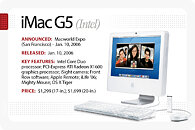Thursday, June 25th 2020

Bad Intel Quality Assurance Responsible for Apple-Intel Split?
Apple's decision to switch from Intel processors for its Mac computers to its own, based on the Arm architecture, has shaken up the tech world, even though rumors of the transition have been doing rounds for months. Intel's first official response, coupled with facts such as Intel's CPU technology execution being thrown completely off gear due to foundry problems; pointed toward the likelihood of Intel not being able to keep up with Apple's growing performance/Watt demands. It turns out now, that Intel's reasons are a lot more basic, and date back to 2016.
According to a sensational PC Gamer report citing former Intel principal engineer François Piednoël, Apple's dissatisfaction with Intel dates back to some of its first 14 nm chips, based on the "Skylake" microarchitecture. "The quality assurance of Skylake was more than a problem," says Piednoël. It was abnormally bad. We were getting way too much citing for little things inside Skylake. Basically our buddies at Apple became the number one filer of problems in the architecture. And that went really, really bad. When your customer starts finding almost as much bugs as you found yourself, you're not leading into the right place," he adds.It was around that time that decisions were taken at the highest levels in Apple to execute a machine architecture switch away from Intel and x86, the second of its kind following Apple's mid-2000s switch from PowerPC to Intel x86. For me this is the inflection point," says Piednoël. "This is where the Apple guys who were always contemplating to switch, they went and looked at it and said: 'Well, we've probably got to do it.' Basically the bad quality assurance of Skylake is responsible for them to actually go away from the platform." Apple's decision to dump Intel may have only been more precipitated with 2019 marking a string of cybersecurity flaws affecting Intel microarchitectures. The PC Gamer report cautions that Piednoël's comments should be taken with a pinch of salt, as he has been among the more outspoken engineers at Intel.Image Courtesy: ComputerWorld
Source:
PC Gamer
According to a sensational PC Gamer report citing former Intel principal engineer François Piednoël, Apple's dissatisfaction with Intel dates back to some of its first 14 nm chips, based on the "Skylake" microarchitecture. "The quality assurance of Skylake was more than a problem," says Piednoël. It was abnormally bad. We were getting way too much citing for little things inside Skylake. Basically our buddies at Apple became the number one filer of problems in the architecture. And that went really, really bad. When your customer starts finding almost as much bugs as you found yourself, you're not leading into the right place," he adds.It was around that time that decisions were taken at the highest levels in Apple to execute a machine architecture switch away from Intel and x86, the second of its kind following Apple's mid-2000s switch from PowerPC to Intel x86. For me this is the inflection point," says Piednoël. "This is where the Apple guys who were always contemplating to switch, they went and looked at it and said: 'Well, we've probably got to do it.' Basically the bad quality assurance of Skylake is responsible for them to actually go away from the platform." Apple's decision to dump Intel may have only been more precipitated with 2019 marking a string of cybersecurity flaws affecting Intel microarchitectures. The PC Gamer report cautions that Piednoël's comments should be taken with a pinch of salt, as he has been among the more outspoken engineers at Intel.Image Courtesy: ComputerWorld

81 Comments on Bad Intel Quality Assurance Responsible for Apple-Intel Split?
2-3-watts is a performance target which is independent of your current "reality".You are wrong here as well.
If you produce smaller boxes with sizes of a smartphone, that for sure will be energy saving compared to if you produce full-sized PC cases that are gigantic and take so much space.
How much material will you process for a box of, let's say, 10 cm x 6 cm x 1 cm, compared to a box 40 cm x 30 cm x 40 cm ?
If the editors of this site would be knowledgeable, they would know every piece of silicon has bugs, kinks and especially when you sell them to so many people there is bound to be something like this.
Heck, AMD even had them in Zen 1, Zen 2 and nobody complained, AMD has a very high defect rate and bad/non working drivers for Navi cards 1 year after release, but I didn't see any article stating this. Still we are suddenly getting a lot of coverage about an intel product which supposedly had bad QA. How hypocrites tech sites have become these days...
I hope you all eat your own words in 1-2 years time, when tables will turn again.
As for the topic, Apple moved to their own cpus to have bigger margins on their products and make more money.
Intel is still struggling with the truth about its processor security flaws
www.theverge.com/2019/11/13/20962667/intel-processor-security-vulnerabilities-researchers-disclosure
www.google.com/search?q=intel+security+issues&oq=intel+security+issues&aqs=chrome.0.0l7.6485j0j7&sourceid=chrome&ie=UTF-8